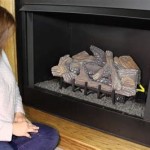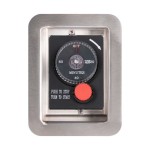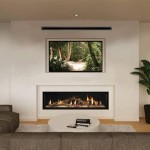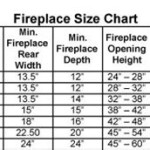How To Makeover a Fireplace
A fireplace, often the focal point of a living room or den, can significantly impact the overall aesthetic of a home. When a fireplace appears dated or fails to complement the existing decor, a makeover provides an opportunity to revitalize the space and enhance its visual appeal. This article details the necessary steps for a successful fireplace makeover, ranging from initial planning and preparation to the final decorative touches.
Assessing the Existing Fireplace
Before commencing any physical alteration, a thorough assessment of the current fireplace is paramount. This involves a detailed inspection of the existing structure, materials, and any potential underlying issues. Consider the fireplace's style, its architectural compatibility with the room, and the existing materials, such as brick, stone, or tile. Document any existing damage such as cracks, loose mortar, or water stains. These issues need to be addressed before proceeding with cosmetic enhancements.
Photographic documentation of the fireplace's current state is highly recommended. This allows for a clear visual comparison of the 'before' and 'after' transformation. It also serves as a valuable reference point during the design and implementation stages.
Evaluate the fireplace's functionality. Is it a working fireplace that is regularly used, or is it primarily decorative? This dictates the type of materials that can be used. Flammable materials should not be used in areas susceptible to extreme heat if the fireplace is used for burning wood.
Finally, consult with a qualified professional, such as a structural engineer or a fireplace specialist, especially if structural changes are being considered. This ensures that the proposed modifications are safe, compliant with local building codes, and will not compromise the structural integrity of the fireplace or the surrounding area.
Planning and Design
Once the assessment is complete, the next step involves meticulous planning and design. This includes defining the desired aesthetic, selecting appropriate materials, and developing a comprehensive plan of action.
Determine the desired style of the renovated fireplace. Explore various design options, such as modern, rustic, traditional, or contemporary. Consider how the new fireplace design will integrate with the existing room's decor and architectural style. Gather inspiration from magazines, online resources, and home design websites.
Select materials that align with the desired aesthetic and the functional requirements of the fireplace. Options include brick, stone, tile, wood, and metal. Consider factors such as durability, heat resistance, maintenance requirements, and cost when making material selections. It is imperative to choose materials that are fire-rated and appropriate for fireplace applications, particularly around the firebox.
Develop a detailed design plan that outlines the specific modifications to be made to the fireplace. This plan should include dimensions, material specifications, and installation instructions. Create a budget that accounts for the cost of materials, tools, and labor. This budget should also include a contingency fund for unexpected expenses that may arise during the renovation process.
Obtain any necessary permits from the local building department before commencing any work. Contact the local authority to determine the required permits and inspections for fireplace renovations. Failure to obtain the necessary permits could result in fines and delays.
Executing the Makeover
With the planning and preparation complete, the execution phase begins. This involves the physical alteration of the fireplace according to the design plan. The following steps provide a general framework for a fireplace makeover, but specific procedures may vary depending on the complexity of the project.
Begin by preparing the work area and protecting surrounding surfaces. Cover floors, walls, and furniture with drop cloths or plastic sheeting to prevent damage from dust, debris, and spills. Use painter's tape to protect edges and trim work.
Remove any existing materials that will be replaced, such as old tile, brick, or wood trim. Use appropriate tools, such as a hammer, chisel, or pry bar, to carefully remove the materials. Dispose of the removed materials properly.
Address any structural repairs that are necessary. Repair cracks, loose mortar, or water damage before proceeding with the cosmetic enhancements. Use appropriate patching compounds or repair materials to restore the structural integrity of the fireplace.
Install the new materials according to the design plan. Follow the manufacturer's instructions for installation procedures. Use appropriate adhesives, mortar, or fasteners to secure the materials in place. Ensure that all surfaces are level and plumb.
Apply any necessary finishes, such as paint, stain, or sealant. Choose finishes that are appropriate for the materials being used and that will complement the overall aesthetic of the fireplace. Apply the finishes according to the manufacturer's instructions.
Install any decorative elements, such as a mantel, surround, or fire screen. These elements can significantly enhance the visual appeal of the fireplace and add a personal touch. Ensure that all decorative elements are securely attached and properly positioned.
Clean the work area thoroughly. Remove all debris, dust, and spills. Dispose of any remaining materials properly. Clean the fireplace and surrounding surfaces with appropriate cleaning agents.
If gas lines are involved with gas fireplace inserts, or if there are any concerns regarding carbon monoxide, contact a certified gas fireplace specialist or a professional that can take carbon monoxide readings when the fireplace is in use. This is to ensure safe operation along with proper ventilation.
Specific Renovation Techniques
Depending on the chosen design and materials, specific renovation techniques may be required. Understanding these techniques is crucial for achieving a professional and aesthetically pleasing result.
Brick Painting or Whitewashing: Painting or whitewashing brick can dramatically alter the appearance of a fireplace. Use a masonry primer before applying paint for optimal adhesion. For a whitewashed effect, dilute the paint with water. Apply thin layers to achieve the desired level of opacity. Consider using a heat-resistant paint if the fireplace is frequently used.
Tile Installation: Installing tile around a fireplace adds texture and visual interest. Choose tiles that are heat-resistant and suitable for fireplace applications. Use a tile adhesive specifically designed for high-temperature environments. Ensure proper spacing between tiles and grout with an appropriate tile grout.
Mantel Replacement: Replacing a mantel is a relatively simple way to update a fireplace. Choose a mantel that complements the style of the fireplace and the room's decor. Ensure that the mantel is securely attached to the fireplace using appropriate fasteners. Follow local building codes for mantel clearances from the firebox opening.
Stone Veneer Application: Applying stone veneer provides the look of natural stone without the weight and expense. Choose a stone veneer that is suitable for fireplace applications. Follow the manufacturer's instructions for installation procedures. Ensure that the stone veneer is securely attached to the fireplace using appropriate adhesives.
Drywall and Framing Modifications: Modifying the framing around a fireplace may be necessary to accommodate new design elements. Ensure that any drywall or framing modifications are performed by a qualified professional. Adhere to local building codes for fireplace clearances and fireproofing requirements. Use fire-resistant materials, such as fire-rated drywall, in areas near the firebox.
Safety Considerations
Fireplace renovations involve inherent safety risks. Prioritizing safety throughout the process is essential to prevent accidents and injuries. These considerations should be adhered to at all times.
Personal Protective Equipment: Wear appropriate personal protective equipment (PPE) at all times, including safety glasses, gloves, and a dust mask. This will protect against eye injuries, skin irritations, and respiratory problems.
Fire Safety: Ensure that the fireplace is properly ventilated and that all combustible materials are kept away from the firebox opening. Install a carbon monoxide detector in the room to alert occupants to the presence of dangerous levels of carbon monoxide.
Electrical Safety: If the fireplace renovation involves any electrical work, such as installing new lighting or wiring, turn off the power to the circuit breaker before commencing any work. Use appropriate electrical tools and materials. Consult with a qualified electrician if needed.
Structural Integrity: Do not compromise the structural integrity of the fireplace or the surrounding area. Consult with a qualified professional before making any structural modifications. Ensure that all structural repairs are performed according to local building codes.
Material Safety: Use materials that are fire-rated and appropriate for fireplace applications. Follow the manufacturer's instructions for the safe handling and disposal of materials. Avoid using flammable or toxic materials near the fireplace.
By following these guidelines, a fireplace makeover can be a rewarding project that enhances the aesthetic appeal and functionality of a home. Thorough planning, careful execution, and strict adherence to safety precautions are essential for a successful and enjoyable renovation experience.

Fireplace Makeover Before And After Sweet Tooth Life

10 Fireplace Makeover Ideas Before And After Regency

25 Beautiful Diy Brick Fireplace Makeovers

Diy Fireplace Makeover Mohawk Creative Home

10 Fireplace Makeover Ideas Before And After Regency

Modern Farmhouse Fireplace Makeover Before After Fueling Mamahood

Before And After 5 Budget Friendly Fireplace Makeovers Makeover Home

Diy Fireplace Makeover At Home With The Barkers

Fireplace Makeover Update Hearth Frame And Blue Gray Boards The Lettered Cottage

Diy Fireplace Makeover At Home With The Barkers








